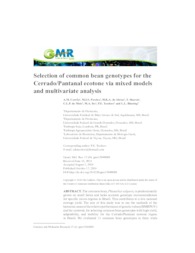Selection of common bean genotypes for the Cerrado/Pantanal ecotone via mixed models and multivariate analysis.
Selection of common bean genotypes for the Cerrado/Pantanal ecotone via mixed models and multivariate analysis.
Author(s): CORRÊA, A. M.; PEREIRA, M. I. S.; ABREU, H. K. A. de; SHARON, R.; MELO, C. L. P. de; ITO, M. A.; TEODORO, P. E.; BHERING, L. L.
Summary: The common bean, Phaseolus vulgaris, is predominantly grown on small farms and lacks accurate genotype recommendations for specific micro-regions in Brazil. This contributes to a low national average yield. The aim of this study was to use the methods of the harmonic mean of the relative performance of genetic values (HMRPGV) and the centroid, for selecting common bean genotypes with high yield, adaptability, and stability for the Cerrado/Pantanal ecotone region in Brazil. We evaluated 11 common bean genotypes in three trials carried out in the dry season in Aquidauana in 2013, 2014, and 2015. A likelihood ratio test detected a significant interaction between genotype x year, contributing 54% to the total phenotypic variation in grain yield. The three genotypes selected by the joint analysis of genotypic values in all years (Carioca Precoce, BRS Notável, and CNFC 15875) were the same as those recommended by the HMRPGV method. Using the centroid method, genotypes BRS Notável and CNFC 15875 were considered ideal genotypes based on their high stability to unfavorable environments and high responsiveness to environmental improvement. We identified a high association between the methods of adaptability and stability used in this study. However, the use of centroid method provided a more accurate and precise recommendation of the behavior of the evaluated genotypes.
Publication year: 2016
Types of publication: Journal article
Unit: Embrapa Soybean
Keywords: Analise multivariada, Cerrado, Feijão, Pantanal
Observation
Some of Embrapa's publications are published as ePub files. To read them, use or download one of the following free software options to your computer or mobile device. Android: Google Play Books; IOS: iBooks; Windows and Linux: Calibre.
Access other publications
Access the Agricultural Research Database (BDPA) to consult Embrapa's full library collection and records.
Visit Embrapa Bookstore to purchase books and other publications sold by Embrapa.

